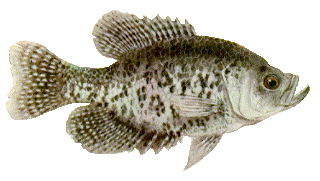The Black Crappie is a large sunfish, it can grow up to 16 inches and it can weigh about 5 pounds. The black crappie has a rounded body with green, silver, and black scales all over its body. They live in warm ponds; lakes; streams; and resevoirs; so they are a fresh water fish. The black crappie is a schooling fish, so they are usually found in groups.
The Black Crappie is a native fish in Eastern-Texas. They are located in the majority of the Texas freshwater bodies. In Texas, they are hunted (fished) for game and for food. The time is unknown of when they were introduced to other states, but people from Texas introduced the fish to all 48 continental states. These fish can cause problems due to their reproduction and eating habits.
The Black Crappie eats fish, like golden shiners; largemouth bass; creek chub; and yellow perch. They eat insects and worms, like water fleas; large diving beetles; yellow jackets; and aquatic worms. They also eat newts; bullfrogs; and amoeba. The black crappie are threats to these species because of their schooling habits, many of their prey are eaten at a time and threatens their population in that body of water, and since many of the animals that compete with the black crappie for food end up losing because the crappie will end up killing and eating it. The black crappie has a few predators that compete with it for other food. The largemouth bass; the great blue heron; the king fisher; the common snapping turtle; sea gulls; and humans are the main predators of the black crappie.
The only way to reduce the black crappie's impact is to fish them for food and for fun.
http://www.fcps.edu/islandcreekes/ecology/black_crappie.htm
http://www.tpwd.state.tx.us/huntwild/wild/species/crappie/
Wednesday, March 23, 2011
Tuesday, March 1, 2011
The Endangered Aye-aye
The Aye-aye is an endangered species of lemur, which is apart of the primate family. Aye-ayes are located on the Eastern Coast of Madagascar. There natural habitat is the rainforest, they create their nest in the canopies of the trees. They sleep during the day and forage for food at night. The Aye-aye eats berries, nuts, fruit and by using their long middle fingers, they chew and poke holes into trees so the can grab grub from inside.
Many Aye-aye are driven out of the forests due to deforestation, so they end up on the streets of the towns nearby. As deforestation continues, many of these animals die, because they are sleeping and do not know what is going on until it is to late. Many are killed when they are being captured for zoos. Due to their odd looking appearance, many people want to capture them and show the world how they look and the way they act. The Aye-aye is very peaceful and extremely friendly, in some cases, they will go up to people and eat food right out of the people's hands.
There is a legend of the Aye-aye in Madagascar. The Malagasy People believe that the Aye-aye is a symbol of death. They say that the Aye-aye will enter into people's homes and use their long, boney middle fingers to stab a person in the heart, killing them. This causes a lot of fear, so when an Aye-aye is spotted inside of a village, the people will take whatever they have, and kill it. This is the main reason why the Aye-aye are endangered, because they are feared, and because they will steal food from the home of the villagers.
http://animals.nationalgeographic.com/animals/mammals/aye-aye/
http://pin.primate.wisc.edu/factsheets/entry/aye-aye
Many Aye-aye are driven out of the forests due to deforestation, so they end up on the streets of the towns nearby. As deforestation continues, many of these animals die, because they are sleeping and do not know what is going on until it is to late. Many are killed when they are being captured for zoos. Due to their odd looking appearance, many people want to capture them and show the world how they look and the way they act. The Aye-aye is very peaceful and extremely friendly, in some cases, they will go up to people and eat food right out of the people's hands.
There is a legend of the Aye-aye in Madagascar. The Malagasy People believe that the Aye-aye is a symbol of death. They say that the Aye-aye will enter into people's homes and use their long, boney middle fingers to stab a person in the heart, killing them. This causes a lot of fear, so when an Aye-aye is spotted inside of a village, the people will take whatever they have, and kill it. This is the main reason why the Aye-aye are endangered, because they are feared, and because they will steal food from the home of the villagers.
http://animals.nationalgeographic.com/animals/mammals/aye-aye/
http://pin.primate.wisc.edu/factsheets/entry/aye-aye
Subscribe to:
Posts (Atom)





